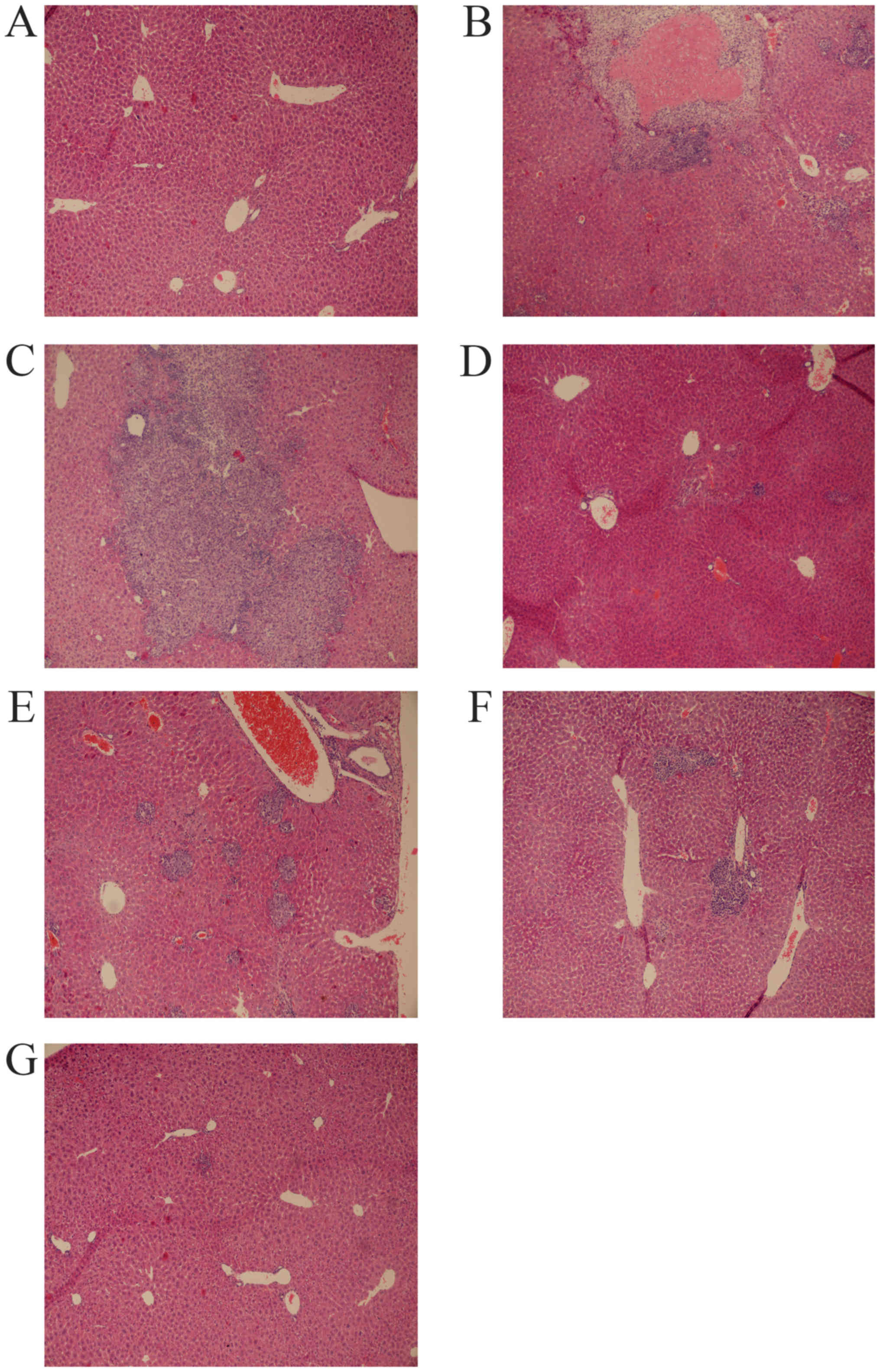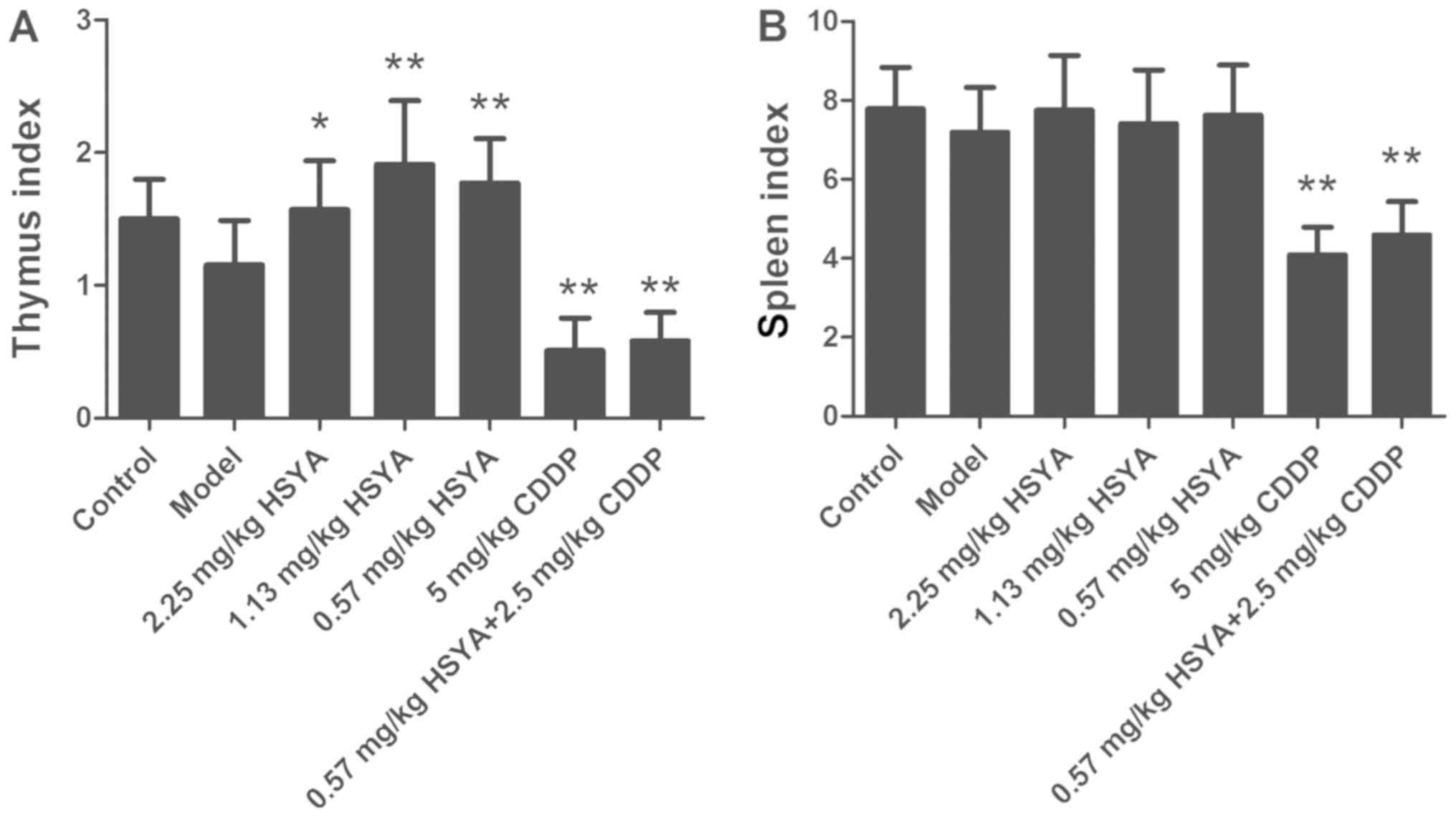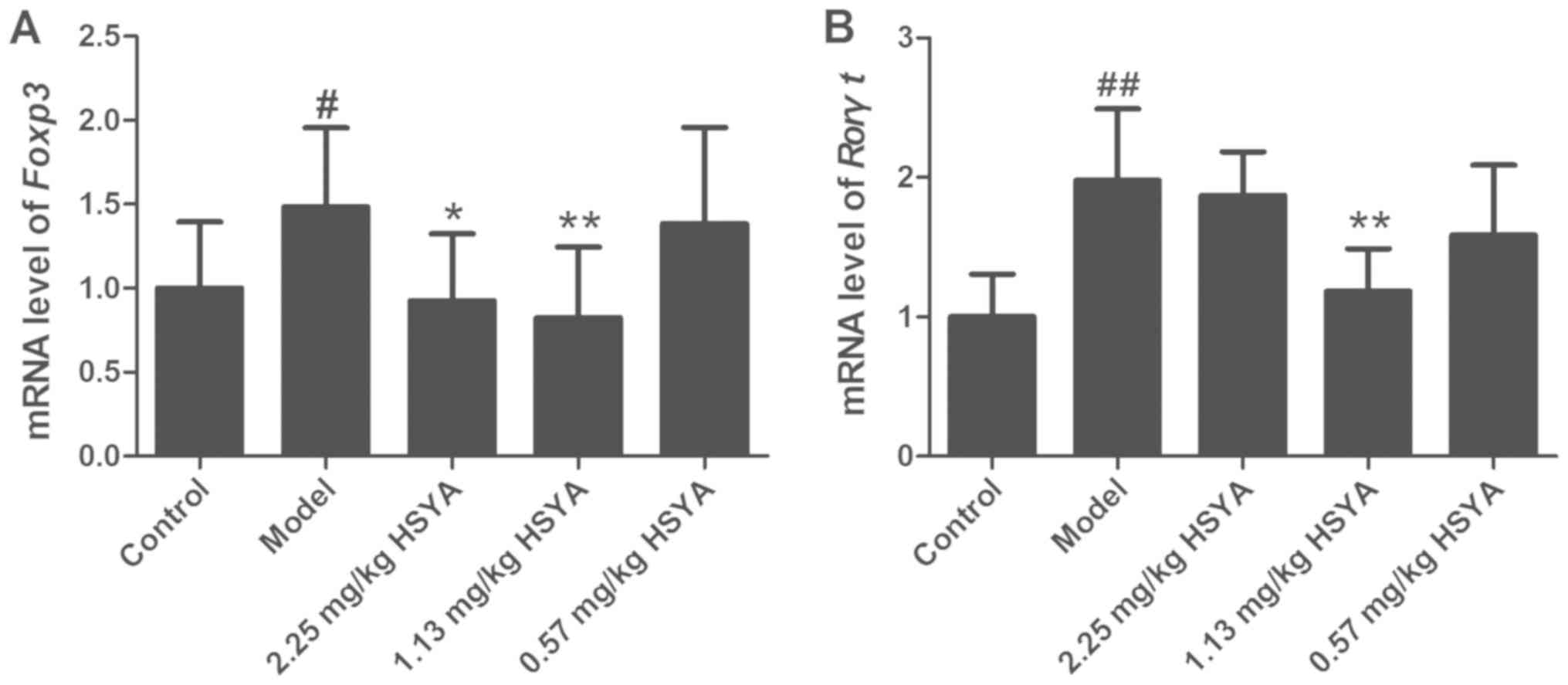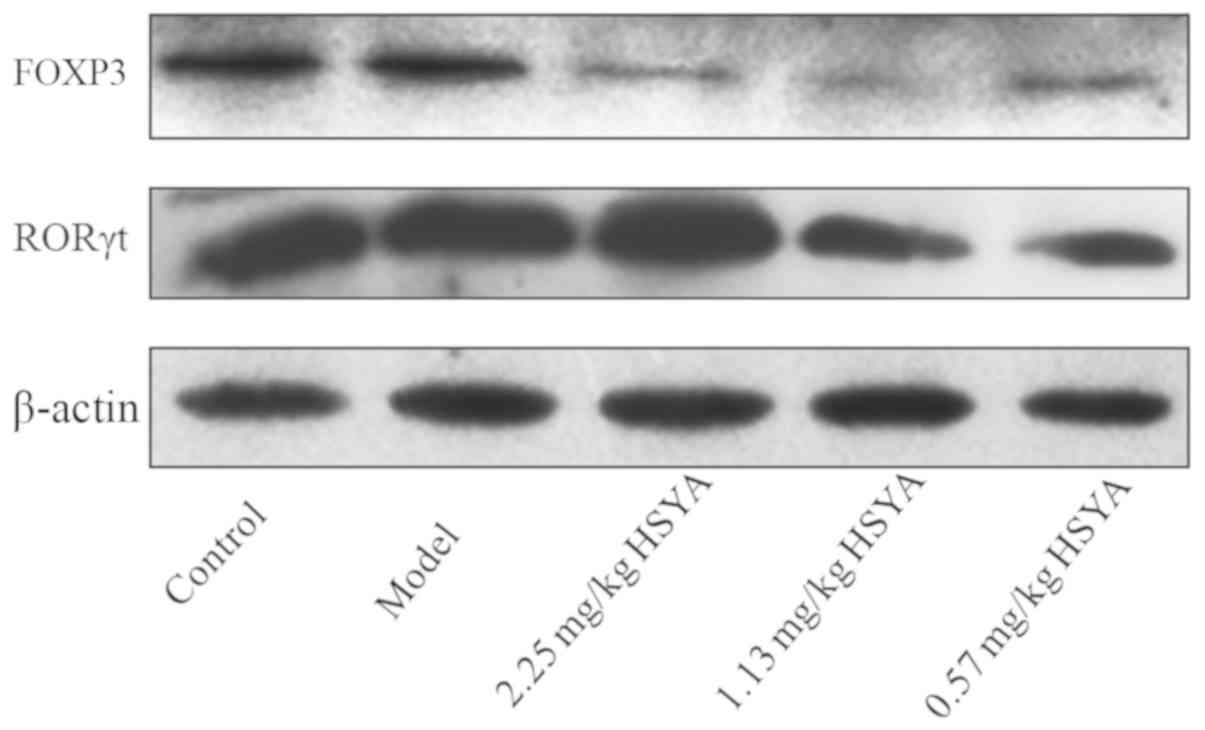|
1
|
Yang JD, Nakamura I and Roberts LR: The
tumor microenvironment in hepatocellular carcinoma: Current status
and therapeutic targets. Semin Cancer Biol. 21:35–43. 2011.
View Article : Google Scholar : PubMed/NCBI
|
|
2
|
Luo P, Yin P, Hua R, Tan Y, Li Z, Qiu G,
Yin Z, Xie X, Wang X, Chen W, et al: A Large-scale, multicenter
serum metabolite biomarker identification study for the early
detection of hepatocellular carcinoma. Hepatology.
28–Sep;2017.(Epub ahead of print).
|
|
3
|
Parkin DM, Bray F, Ferlay J and Pisani P:
Global cancer statistics, 2002. CA Cancer J Clin. 55:74–108. 2005.
View Article : Google Scholar : PubMed/NCBI
|
|
4
|
Ferlay J, Shin HR, Bray F, Forman D,
Mathers C and Parkin DM: Estimates of worldwide burden of cancer in
2008: GLOBOCAN 2008. Int J Cancer. 127:2893–2917. 2010. View Article : Google Scholar : PubMed/NCBI
|
|
5
|
Chen JG: Trends in the incidence of liver
cancer and its primary prevention in China. J Clin Hepatol.
28:256–260. 2012.
|
|
6
|
Bruix J and Sherman M; American
Association for the Study of Liver Diseases, : Management of
hepatocellular carcinoma: An update. Hepatology. 53:1020–1022.
2011. View Article : Google Scholar : PubMed/NCBI
|
|
7
|
Karaman B, Battal B, Sari S and Verim S:
Hepatocellular carcinoma review: Current treatment, and
evidence-based medicine. World J Gastroenterol. 20:18059–18060.
2014. View Article : Google Scholar : PubMed/NCBI
|
|
8
|
Greten TF, Wang XW and Korangy F: Current
concepts of immune based treatments for patients with HCC: From
basic science to novel treatment approaches. Gut. 64:842–848. 2015.
View Article : Google Scholar : PubMed/NCBI
|
|
9
|
Mbeunkui F and Johann DJ Jr: Cancer and
the tumor microenvironment: A review of an essential relationship.
Cancer Chemother Pharmacol. 63:571–582. 2009. View Article : Google Scholar : PubMed/NCBI
|
|
10
|
Fritz JM, Dwyer-Nield LD and Malkinson AM:
Stimulation of neoplastic mouse lung cell proliferation by alveolar
macrophage-derived, insulin-like growth factor-1 can be blocked by
inhibiting MEK and PI3K activation. Mol Cancer. 10:762011.
View Article : Google Scholar : PubMed/NCBI
|
|
11
|
Liu J, Zhang H, Jia L and Sun H: Effects
of Treg cells and IDO on human epithelial ovarian cancer cells
under hypoxic conditions. Mol Med Rep. 11:1708–1714. 2015.
View Article : Google Scholar : PubMed/NCBI
|
|
12
|
Mathai AM, Kapadia MJ, Alexander J,
Kernochan LE, Swanson PE and Yeh MM: Role of Foxp3-positive
tumor-infiltrating lymphocytes in the histologic features and
clinical outcomes of hepatocellular carcinoma. Am J Surg Pathol.
36:980–986. 2012. View Article : Google Scholar : PubMed/NCBI
|
|
13
|
Castro G, Liu X, Ngo K, De Leon-Tabaldo A,
Zhao S, Luna-Roman R, Yu J, Cao T, Kuhn R, Wilkinson P, et al:
RORγt and RORα signature genes in human Th17 cells. PLoS One.
12:e01818682017. View Article : Google Scholar : PubMed/NCBI
|
|
14
|
Liao R, Sun J, Wu H, Yi Y, Wang JX, He HW,
Cai XY, Zhou J, Cheng YF, Fan J and Qiu SJ: High expression of
IL-17 and IL-17RE associate with poor prognosis of hepatocellular
carcinoma. J Exp Clin Cancer Res. 32:32013. View Article : Google Scholar : PubMed/NCBI
|
|
15
|
Zhang Q, Zheng J, Wang L, et al:
Therapeutic effect of Ramosetron on preventing gastrointestinal
reaction induced by chemotherapeutic drugs including Cisplatin in
80 cases. Chin Pharm. 10:1024–1025. 2007.
|
|
16
|
Liu ZQ, Cheng JT, Zhu HX, et al:
Experimental study on increasing effect and decreasing its
side-effect of Cisplatin of LiuJunZi decoction. Lishizhen Medicine
and Materia Medical Research. 20:2492–2494. 2009.
|
|
17
|
Wu H, Lv SZ, Ying XZ, Ye YL and Tian ZF:
Effect of traditional Chinese medicine in immunity recovery of
radiotherapy in patients with liver cancer. Chin Archiv Trad Chin
Med. 8:1997–1999. 2015.(In Chinese).
|
|
18
|
Wu QL, Lu HD, Guo XL and Kong QZ:
Exploration of treatment of malignant tumors with Chinese herbs
that invigorate the blood and remove stasis. J Int Trad Western
Med. 5:530–531. 2010.
|
|
19
|
Zhou X, Tang L, Xu Y, Zhou G and Wang Z:
Towards a better understanding of medicinal uses of Carthamus
tinctorius L. in traditional Chinese medicine: A phytochemical and
pharmacological review. J Ethnopharmacol. 151:27–43. 2014.
View Article : Google Scholar : PubMed/NCBI
|
|
20
|
Wang J, Wang P, Gui S, Li Y, Chen R, Zeng
R, Zhao P, Wu H, Huang Z and Wu J: Hydroxysafflor yellow A
attenuates the apoptosis of peripheral blood CD4+ T
lymphocytes in a murine model of sepsis. Front Pharmacol.
8:6132017. View Article : Google Scholar : PubMed/NCBI
|
|
21
|
Xie H, Zhang Q, Zhao YQ, Cui W and Niu X:
The experiment of safflor yellow effecting the cell growth cycle of
mouse H22 grafting tumor. China J Tradit Chin Med Pharm. 171–173.
2006.(In Chinese).
|
|
22
|
Ma L, Liu L, Ma Y, Xie H, Yu X, Wang X,
Fan A, Ge D, Xu Y, Zhang Q and Song C: The role of
E-cadherin/β-catenin in hydroxysafflor yellow A inhibiting
adhesion, invasion, migration and lung metastasis of hepatoma
cells. Biol Pharm Bull. 40:1706–1715. 2017. View Article : Google Scholar : PubMed/NCBI
|
|
23
|
Xi S, Zhang Q, Xie H, Liu L, Liu C, Gao X,
Zhang J, Wu L, Qian L and Deng X: Effects of hydroxy safflor yellow
A on blood vessel and mRNA expression with VEGF and bFGF of
transplantation tumor with gastric adenocarcinoma cell line BGC-823
in nude mice. Zhongguo Zhong Yao Za Zhi. 34:605–610. 2009.(In
Chinese). PubMed/NCBI
|
|
24
|
Wang J, Zhang Q, Gu LG, Cui W, Xie H and
Niu XY: Effect of hydroxy safflor yellow A on the cell cycle and
apoptosis of human umbilical vein endothelial cells with the
stimulus of tumor cell conditioned medium. J Beijing Univ Tradit
Chin Med. 31:741–744. 2008.(In Chinese).
|
|
25
|
Xi SY, Zhang Q, Liu CY, et al: Effects of
hydroxy safflower yellow A on the expression of bFGF protein and
MMP-9 in human gastric cancer xenografts. Chin J Chin Materia.
21:2877–2881. 2010.(In Chinese).
|
|
26
|
Xi SY, Zhang Q, Liu CY, Xie H, Yue LF, Li
WD, Zang BX and Gao XM: Effects of HSYA on protein and mRNA
expression of KDR, HIF-1α and protein expression of VEGF in nude
mice with BGC-823 transplantation tumor. Chin J Trad Chin Med
Pharm. 27:82–87. 2012.
|
|
27
|
Limani P, Borgeaud N, Linecker M, Tschuor
C, Kachaylo E, Schlegel A, Jang JH, Ungethüm U, Montani M, Graf R,
et al: Selective portal vein injection for the design of syngeneic
models of liver malignancy. Am J Physiol Gastrointest Liver
Physiol. 310:G682–G688. 2016. View Article : Google Scholar : PubMed/NCBI
|
|
28
|
Lu YM and Zhang H: Effects of
electroacupuncture on T-lymphocytes, spleen index, thymus index and
lymphopoiesis levels in strenuous exercise-induced stress rat. Zhen
Ci Yan Jiu. 37:136–139. 2012.PubMed/NCBI
|
|
29
|
Livak KJ and Schmittgen TD: Analysis of
relative gene expression data using real-time quantitative PCR and
the 2(-Delta Delta C(T)) method. Methods. 25:402–408. 2001.
View Article : Google Scholar : PubMed/NCBI
|
|
30
|
Dong F, Xue C, Wang Y, Peng Y, Zhang Y,
Jin M and Zang B: Hydroxysafflor yellow A attenuates the expression
of inflammatory cytokines in acute soft tissue injury. Sci Rep.
7:405842017. View Article : Google Scholar : PubMed/NCBI
|
|
31
|
Min J and Wei C: Hydroxysafflor yellow A
cardioprotection in ischemia-reperfusion (I/R) injury mainly via
Akt/hexokinase II independent of ERK/GSK-3β pathway. Biomed
Pharmacother. 87:419–426. 2017. View Article : Google Scholar : PubMed/NCBI
|
|
32
|
Wang T, Duan SJ, Wang SY, Lu Y, Zhu Q,
Wang LJ and Han B: Coadministration of hydroxysafflor yellow A with
levodopa attenuates the dyskinesia. Physiol Behav. 147:193–197.
2015. View Article : Google Scholar : PubMed/NCBI
|
|
33
|
Sun L, Yang L, Xu YW, Liang H, Han J, Zhao
RJ and Cheng Y: Neuroprotection of hydroxysafflor yellow A in the
transient focal ischemia: inhibition of protein
oxidation/nitration, 12/15-lipoxygenase and blood-brain barrier
disruption. Brain Res. 1473:227–235. 2012. View Article : Google Scholar : PubMed/NCBI
|
|
34
|
Wu XL: Efficacy enhancing effect of
Shikonin on human liver cancer HepG2 cells treated by Cisplatin.
Chin Med J Res Prac. 31:35–38. 2017.(In Chinese).
|
|
35
|
Wu Y and Liu R: Study on the
drug-resistant reversal effects of ginsenoside Rh2 in human
hepatocellular carcinoma HepG2/ADM cells and its mechanism. J Med
Postgra. 30:476–480. 2017.
|
|
36
|
Park HR, Ju EJ, Jo SK, Jung U, Kim SH and
Yee ST: Enhanced antitumor efficancy of cisplatin in combination
with HemoHIM in tumor-bearing mice. BMC Cancer. 9:852009.
View Article : Google Scholar : PubMed/NCBI
|
|
37
|
Liu Y, Jing Y, Guo LL, et al: Effects of
Guben Zhike Recipe on the spleen index, thymus index and Th1/Th2
unbalance in COPD mice. China J Tradit Chin Med Pharm. 2015.(In
Chinese).
|
|
38
|
Fontenot JD, Rasmussen JP, Williams LM,
Dooley JL, Farr AG and Rudensky AY: Regulatory T cell lineage
specification by the forkhead transcription factor foxp3. Immunity.
22:329–341. 2005. View Article : Google Scholar : PubMed/NCBI
|
|
39
|
Fu J, Xu D, Liu Z, Shi M, Zhao P, Fu B,
Zhang Z, Yang H, Zhang H, Zhou C, et al: Increased regulatory T
cells correlate with CD8 T-cell impairment and poor survival in
hepatocellular carcinoma patients. Gastroenterology. 132:2328–2339.
2007. View Article : Google Scholar : PubMed/NCBI
|
|
40
|
Lin SZ, Chen KJ, Xu ZY, Chen H, Zhou L,
Xie HY and Zheng SS: Prediction of recurrence and survival in
hepatocellular carcinoma based on two Cox models mainly determined
by FoxP3+ regulatory T cells. Cancer Prev Res (Phila).
6:594–602. 2013. View Article : Google Scholar : PubMed/NCBI
|
|
41
|
Takeuchi Y and Nishikawa H: Roles of
regulatory T cells in cancer immunity. Int Immunol. 28:401–409.
2016. View Article : Google Scholar : PubMed/NCBI
|
|
42
|
Zhang JP, Yan J, Xu J, Pang XH, Chen MS,
Li L, Wu C, Li SP and Zheng L: Increased intratumoral
IL17-producing cells correlate with poor survival in hepatocellular
carcinoma patients. J Hepatol. 50:980–989. 2009. View Article : Google Scholar : PubMed/NCBI
|
|
43
|
Huang Y, Wang F, Wang Y, Zhu Z, Gao Y, Ma
Z, Xu R and Du Z: Intrahepatic interleukin-17+ T cells
and FoxP3+ regulatory T cells cooperate to promote
development and affect the prognosis of hepatocellular carcinoma. J
Gastroenterol Hepatol. 29:851–859. 2014. View Article : Google Scholar : PubMed/NCBI
|
|
44
|
Lin ZW, Wu LX, Xie Y, Ou X, Tian PK, Liu
XP, Min J, Wang J, Chen RF, Chen YJ, et al: The expression levels
of transcription factors T-bet, GATA-3, RORγt and FOXP3 in
peripheral blood lymphocyte (PBL) of patients with liver cancer and
their significance. Int J Med Sci. 12:7–16. 2015. View Article : Google Scholar : PubMed/NCBI
|














